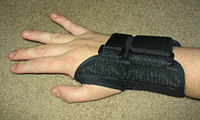
Photo from wikipedia
The purpose of the current study was to investigate the robustness of dynamic simulation results in the presence of uncertainties resulting from application of a scaled-generic musculoskeletal model instead of… Click to show full abstract
The purpose of the current study was to investigate the robustness of dynamic simulation results in the presence of uncertainties resulting from application of a scaled-generic musculoskeletal model instead of a subject-specific model as well as the effect of the choice of simulation method on the obtained muscle forces. The performed sensitivity analysis consisted of the following multibody parameter modifications: maximum isometric muscle forces, number of muscles, the hip joint center location, segment masses, as well as different dynamic simulation methods, namely static optimization (SO) with three different criteria and a computed muscle control (CMC) algorithm (hybrid approach combining forward and inverse dynamics). Twenty-four different models and fifty-five resultant dynamic simulation data sets were analyzed. The effects of model perturbation on the magnitude and profile of muscle forces were compared. It has been shown that estimated muscle forces are very sensitive to model parameters. The greatest impact was observed in the case of the force magnitude of the muscles generating high forces during gait (regardless of the modification introduced). However, the force profiles of those muscles were preserved. Relatively large differences in muscle forces were observed for different simulation techniques, which included both magnitude and profile of muscle forces. Personalization of model parameters would affect the resultant muscle forces and seems to be necessary to improve general accuracy of the estimated parameters. However, personalization alone will not ensure high accuracy due to the still unresolved muscle force sharing problem.
Journal Title: Journal of Biomechanical Engineering
Year Published: 2018
Link to full text (if available)
Share on Social Media: Sign Up to like & get
recommendations!